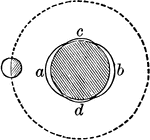Clipart tagged: ‘satellites’

Cause of the Phases of the Moon
During new and full moon, the earth, moon, and sun are all in the same straight line, but, that during…

Lunar Tide
If the earth were uniformly covered with a layer of water, the passage of the moon over any place as…

Positions
The flood tides are the highest, and the ebb tides are the lowest. These are called spring tides.…